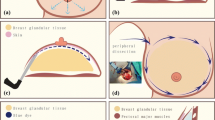Abstract
Background
Dual-plane techniques offer excellent pocket locations for breast augmentation. Traditional techniques require incisions in the inframammary or periareolar crease, which are rarely accepted in the authors’ department because of visible scars on the breast. Therefore, the authors developed a transaxillary approach for dual-plane procedures using an endoscope.
Methods
During a period of 36 months between April 2009 and March 2012, 89 consecutive patients with small breasts were treated surgically. They underwent transaxillary types 2 or 3 dual-plane breast augmentation as outpatients. For the axillary endoscopic subglandular tunneling approach (AESTA), a long subglandular tunnel was created along the lateral portion of the pectoralis major muscle to reach the nipple–areolar complex. The type 2 dual-plane technique was applied in 67 patients, and the type 3 technique was used in 22 patients.
Results
The mean age of the patients was 37.5 years (range 31–48 years), and the mean postoperative follow-up period was 11 months (range 7–42 months). Good surgical outcomes were obtained, and the procedure was reproducible.
Conclusions
The use of AESTA allowed the authors to achieve types 2 and 3 dual-plane breast augmentation through a transaxillary incision. They believe that AESTA can yield constant and satisfactory outcomes similar to the inframammary and periareolar approaches.
Level of Evidence V
This journal requires that authors assign a level of evidence to each article. For a full description of these Evidence-Based Medicine ratings, please refer to the Table of Contents or the online Instructions to Authors www.springer.com/00266.








Similar content being viewed by others
References
Alpert BS, Lalonde DH (2008) MOC-PS(SM) CME article: breast augmentation. Plast Reconstr Surg 121:1–7
Tebbetts JB (2001) Dual-plane breast augmentation: optimizing implant–soft tissue relationships in a wide range of breast types. Plast Reconstr Surg 107:1255–1272
Copeland SE, Ladd LA, Gu XQ, Mather LE (2008) The effect of general anesthesia on the central nervous and cardiovascular system toxicity of local anesthetics. Anesth Analg 106:1140–1149
Liu P, Feldman HS, Covino BM, Giasi R, Covino BG (1982) Acute cardiovascular toxicity of intravenous amide local anesthetics in anesthetized ventilated dogs. Anesth Analg 61:317–322
Adams WP Jr, Conner WC, Barton FE Jr, Rohrich RJ (2000) Optimizing breast pocket irrigation: an in vitro study and clinical implications. Plast Reconstr Surg 105:334–338
Tebbetts JB (2002) Achieving a predictable 24-h return to normal activities after breast augmentation: Part II. Patient preparation, refined surgical techniques, and instrumentation. Plast Reconstr Surg 109:293–305
Ho LC (1993) Endoscopic-assisted transaxillary augmentation mammaplasty. Br J Plast Surg 46:332–336
Serra-Renom J, Garrido MF, Yoon T (2005) Augmentation mammaplasty with anatomic soft, cohesive silicone implant using the transaxillary approach at a subfascial level with endoscopic assistance. Plast Reconstr Surg 116:640–645
Momeni A, Padron NT, Bannasch H, Borges J, Bjorn Stark G (2006) Endoscopic transaxillary subpectoral augmentation mammaplasty: a safe and predictable procedure. J Plast Reconstr Aesthet Surg 59:1076–1081
Villafane O, Garcia-Tutor E, Taggart I (2000) Endoscopic transaxillary subglandular breast augmentation using silicone gel textured implants. Aesthet Plast Surg 24:212–215
Stumpfle RL, Pereirs-Lima LF, Valiati AA, Mazzini GS (2012) Transaxillary muscle-splitting breast augmentation: experience with 160 cases. Aesthet Plast Surg 36:343–348
Luan J, Mu D, Mu L (2009) Transaxillary dual-plane augmentation mammaplasty: experience with 98 breasts. J Plast Reconstr Aesthet Surg 62:1459–1463
Tebbetts JB (2006) Axillary endoscopic breast augmentation: processes derived from a 28-year experience to optimize outcomes. Plast Reconstr Surg 118:53S–80S
Acknowledgments
This work was supported by a 2012 Inje University Research Grant.
Conflict of interest
The authors declare that they have no conflicts of interest to disclose.
Author information
Authors and Affiliations
Corresponding author
Rights and permissions
About this article
Cite this article
Lee, S.H., Yoon, W.J. Axillary Endoscopic Subglandular Tunneling Approach for Types 2 and 3 Dual-Plane Breast Augmentation. Aesth Plast Surg 38, 521–527 (2014). https://doi.org/10.1007/s00266-014-0306-6
Received:
Accepted:
Published:
Issue Date:
DOI: https://doi.org/10.1007/s00266-014-0306-6




